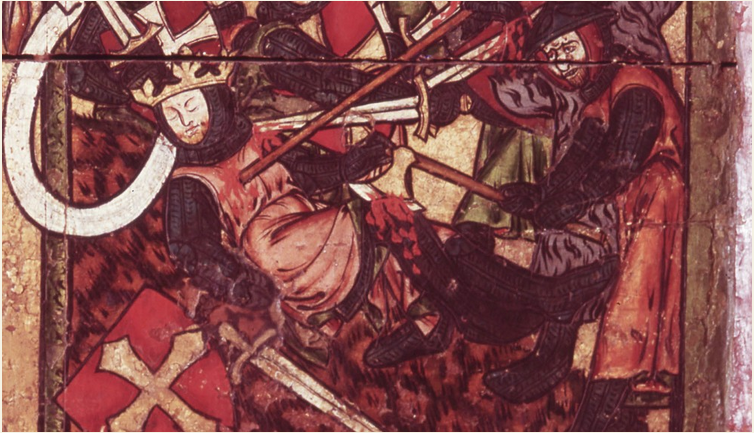For hundreds of years, pilgrims trekked through Norway on a series of “Pilegrimsleden” (Pilgrim’s routes). Some 7 different routes, stretching 3.000 kilometers, though epic landscapes, linked parts of wider Scandinavia to Nidaros Cathedral in Trondheim. Hiking on them is now a major tourist attraction and a different way to see Norway.
Olaf II Haraldsson: King, saint, and Christian icon
For many, Norway’s history revolves around pagan Vikings terrorizing everyone from Ireland to Istanbul. However, there is one figure who symbolizes the change that Norway was undertaking in the latter years of the “Viking Age” (approximately 800-1100 CE): Olaf II Haraldsson.
Olaf was King of Norway from 1015 to 1028 CE and was traditionally seen as helping to spread Christianity in Norway during his reign. Following his death, he was sainted in 1164 CE and given the title “Rex Perpetuus Norvegiae” (The Perpetual King of Norway) and canonized at Nidaros Cathedral in Trondheim. His sainthood further encouraged the adoption of Christianity by the pagan population of Norway.
The legends surrounding his rule and his sainthood became an important part of Norwegian national folklore and central to national identity. For hundreds of years after this death, Christian pilgrims flocked to Nidaros Cathedral to visit his tomb using a series of well-established routes that connected Norway first with the rest of Scandinavia and then much of Northern Europe. These routes in Norway are often called “Saint Olav’s Way.”

St. Olav’s Way: 7 different routes through Norway
There are 7 different “pilgrim’s routes” that dissect Norway. These are :
1) The Gudbrandsdalen Path: the most common Pilgrim Route used as this was once the only major road to Nidaros (Trondheim) for hundreds of years. Starting in Oslo it stretches 642 kilometers and highlights include trekking through the scenic valley of Gudbrandsdalen.
2) The North Parth: this begins at Gloshaug Church in Gloshaugen and winds southwards for 299 kilometers to then connect to Saint Olav’s Way and onto Nidaros Cathedral.
3) Saint Olav’s Path: A 563-kilometer route that stretches from Selånger in Sweden to Stiklestad in Norway. Follows the path Olav took on the way to the Battle of Stikkelstad in 1030 where he was killed.
4) The Østerdalen Path: This is the path reserved for only the most experienced of hikers as it crosses wild and rugged terrain. Traverses for almost 500 kilometers.
5) Valldals Path: the newest of the pilgrim’s routes, it winds its way between fjords and mountains. Follows the route that St. Olav took in the winter of 1028 when he landed at Valldall and trekked 30 kilometers over snow-ridden mountains.
6) The Borg Path: The path that is best suited for cyclists. This spans parts of Østfold and Akershus counties and is the easiest of the routes. It runs for 175 kilometers before connecting onto the Gudbrandsdalen Path.
7) The Rombo Path: This connects Skardøra, on the Swedish border with Norway, to Nidaros Cathedral, a distance of 150 kilometers. The first stretch of this path is mountain terrain at over 1.000 meters above sea so expect snowy conditions, even in warmer weather!

What are the best preparations to have before heading out on one of the Pilgrim’s Routes?
The routes are for everyone in every sort of fitness and condition. Where once religious devotion was the main reason for hiking along these routes, tourism is now the major reason why so many people make the journey along these well-trodden paths.
The weather can be extremely varied and can change almost instantly. As such, even in summer conditions, some sections of the routes can experience wild weather conditions. Regardless of whether you’re hiking for a day, a week or the entire course of a route, suitable clothes and comfortable shoes should be worn. Like any outdoor activity in Norway, the most pleasant time to do it is during the warmer months, from May until August. From September onwards you will be braving either rain or even snow.
It is also worth noting that there are sleeping hostels and pilgrim centers along the various paths. In the warmer months, these may well be full so make sure you plan ahead. Most trekkers that walk more than a day often camp out in a tent…or a sleeping bag under the stars. If you’re lucky, there are quite a few farms that are not only full of history but also hospitality for travelers too.
Remember that Norway has its own “Mountain Code” – a set of unwritten rules about hiking that should be known by those undertaking any trek on these routes.
What is the level of difficulty along the routes?
For those that do not want to use GPS, each of the routes is very well marked. The most popular, the Gudbrandsdalen path, has adequate signage alongside. Due to its popularity the world over, you will also see fellow hikers along the way. Each of the routes passes through major cities, towns, and villages as well as some scenic and tranquil landscapes.
The routes are run by the National Pilgrim Center and you can plan your own route on their website here. There are, of course, the famous sign makers – a red cross on a white background – touching on the Christian heritage of the routes. These are dotted throughout each of the trails so keep an eye open for them.

The Pilgrim Passport and St. Olav’s Letter
Similar to the Santiago De Compostela in Spain, St. Olav’s Way is a major recognized religious trail. Travelers can pick up a “pilgrim passport,” in many pilgrim centers and tourist offices, and have it stamped along the way at a number of establishments.
Those that complete the last 100 kilometers of any of the routes on foot (or 200 kilometers on a bike), into Nidaros Cathedral, will receive an official Olasbrev (St. Olav’s Letter). This is awarded at the Nidaros Pilgrim Center and you must have proof (in the form of a stamped Pilgrim Passport) that you have completed this last stage of any of the routes.
Should you choose any of these routes, you will be following in the footsteps of both ancient royalty and modern. Princess Ingrid Alexandra hiked the last part of St. Olav’s Way as part of preparations for her confirmation in 2019.
More information on St. Olav’s Way and the other routes available can be found on the National Pilgrim Center’s website here.
Source : #Norway Today / #NorwayTodayTravel
Do you have a news tip for Norway Today? We want to hear it. Get in touch at [email protected]






Be the first to comment on "Following in the footsteps of a saint: Trekking St. Olav’s Way to Trondheim"